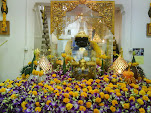The legend of the ancient Buddha image at Wat Phra Thong stretches back centuries — and is as intriguing today as it ever was. Protected by an ancient spell, the half-buried Buddha image has withstood man’s every attempt to remove it from the ground.
A young buffalo boy tied his animal’s lead to a hard, muddy object sticking up from a field in the north of Phuket – and suddenly died.
On this island it’s one of the best known of all legends. Like fables everywhere, it tells us much about the mores of its own society. Here a point very significant to Thai society - one to be remembered - comes from the special nature of the dirty, hard object sticking up from the rice field outside Thalang. It happened to be a part of an ancient, buried Buddha image, the spiral-like point rising from the top of an image’s head.
Why did the boy die? Thais consider the head the most elevated, most sacred part of the body, and that of a Buddha image is many times more holy. A lowly buffalo (despite the fact that Thais view these beasts of burden with a special affection, they’re considered the epitome of thick-headedness) being tied to so sacred an object is an insult of the most gross proportions.
Yet more, this Buddha image is widely believed to embody an ancient spell, and with it special spiritual powers. Today virtually every Thai visiting Phuket for the first time will make a pilgrimage here. Busloads of coarsely dressed villagers from distant provinces kneel before this image, alongside the country's refined elite, their Mercedes Benzes waiting outside.
In the hazy centuries of Phuket’s distant past, the famous young buffalo boy was laid to rest. The father cremated his son, and returned to fetch the buffalo. It, too, was dead. The father washed off the mysterious hard object to which the animal had been tied, and to his surprise found it resembled the tip of a Buddha image. The villagers reported the discovery to the ruling "Prince of the Province" at Bon Don on the coast.dig was ordered. As villagers put their tools to the object, hordes of angry wasps descended, driving off anyone who attempted to disturb whatever lay below the soil. Still they dug, revealing the face of Buddha cast from solid gold. But no matter what they tried, only the head could be bared. Eventually, their Prince ordered a shelter built right over it.
In the mid-1700s all of Thailand began to suffer the ravages of invading Burmese armies. Phuket was attacked, and eventually occupied. Gold, naturally, was one of the invaders’ passions. The Burmese general lusted for the gold Buddha.
Again, disaster befell any Burmese who attempted to dig at the image. A plague of ants arose in masses as thick as palms. Bitten, the Burmese died. But the general wouldn’t desist, and drove his men till hundreds were dead. Still, they could get only as deep as the golden image’s throat. Finally the Burmese armies were driven out with the Buddha still buried in a field outside Thalang township.
When the Burmese threatened Phuket in later years, the golden head and its protruding spiral-like tip were disguised by the construction of a much larger Buddha head directly over it. This large head and shoulders is the same one we can see today in the temple of Wat Phra Thong, The "Golden Buddha Temple", outside present-day Thalang.
Soon after the Burmese invasions a tudong monk, one of the those who wander endlessly without the comfort of a home monastery, arrived at the buried Buddha, and, feeling he could go no further, settled to build a temple over the image.
This founding abbot died, leaving a mystical riddle embodying a spell. In the form of a poem, this contained the three paradoxes involving the hierarchy of the spirits in the Phuket region and the Golden Buddha’s head.
Any future monk who wanted to remain abbot presiding over the temple of so powerful a Buddha image, the abbot said before dying, would have to first prove sufficient enlightenment to solve this riddle.
Thereafter, 13 monks successfully assumed the position of abbot at Wat Phra Thong. Then came a period – perhaps a low ebb in Buddhist learning – when no monk could answer the riddle. New abbots would die, go crazy or be driven from the monastery.
Finally in 1897, a foreign monk who was just 23 years of age, unravelled the riddle’s mystery.
This monk became the famous Luang Por Phra Kuwittatan, and presided over the monastery for 64 years.The influence that this buried Buddha image has over the people of Phuket and beyond is difficult to appreciate. But today one can readily visit the temple at Thalang and see the image, and once there, it is difficult not to be impressed. For the sense of mystery that surrounds this ancient image is just as strong today as it ever was.
Saturday, 30 May 2009
Subscribe to:
Post Comments (Atom)


No comments:
Post a Comment